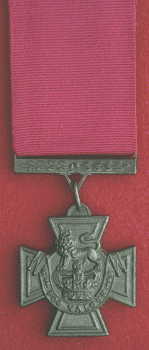 The Victoria Cross is the highest honour which can be received for conduct in action. It was instituted in 1865 by Queen Victoria at the end of the Crimean War. At that time, awards for gallantry could only be made to officers and normally to those within the commander-in-chief's staff. While the Distinguished Conduct Medal had been instituted to allow for recognition of non-commissioned officers and privates, the need for an award open to all, regardless of rank, was recognized by Queen Victoria. In 1855, the Duke of Newcastle wrote that "it does not seem to me right or politic that such deeds of heroism as the war has produced should go unrewarded by a distinctive mark of honour because they are done by privates or officers below the rank of major." The final words in the Royal Warrant specified that the medal was to be awarded "to those officers or men who have served Us in the presence of the Enemy and shall then have performed some signal act of valour or devotion to their country."
The Victoria Cross is the highest honour which can be received for conduct in action. It was instituted in 1865 by Queen Victoria at the end of the Crimean War. At that time, awards for gallantry could only be made to officers and normally to those within the commander-in-chief's staff. While the Distinguished Conduct Medal had been instituted to allow for recognition of non-commissioned officers and privates, the need for an award open to all, regardless of rank, was recognized by Queen Victoria. In 1855, the Duke of Newcastle wrote that "it does not seem to me right or politic that such deeds of heroism as the war has produced should go unrewarded by a distinctive mark of honour because they are done by privates or officers below the rank of major." The final words in the Royal Warrant specified that the medal was to be awarded "to those officers or men who have served Us in the presence of the Enemy and shall then have performed some signal act of valour or devotion to their country."The Victoria Cross is a bronze cross patée, one-and-a-half inches across, with a lion statant gardant on the Royal Crown on the obverse side. Below the Crown are the words "FOR VALOUR." The original medals were cast from bronze obtained from two eighteen-pounder Russian guns captured in the Crimea.
In 1867, the award of the decoration was extended to officers and men of the Colonial Forces. In 1902, King Edward declared that, for soldiers or sailors killed before receiving their medal, the Victoria Cross would be sent to their relatives.
Prior to the Second World War, sixty-six Canadian soldiers and sailors had received the Victoria Cross, twenty-two of these posthumously.